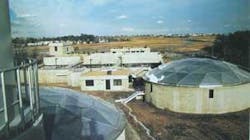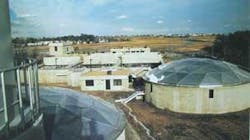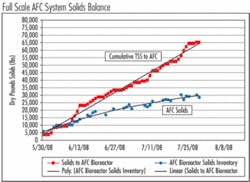by Donald R. Rodgers, Jr., Richard J. Colvin, Christian D. Hahn and Philippe Maltais
The Town of Seabrook, NH, operates a conventional wastewater treatment plant built in 1996. The plant is designed for an average daily flow of 1.8 mgd with a loading of 3800 lb/day BOD and 4700 lb/day TSS (253 mg/L and 313 mg/L, respectively). The treatment train consists of influent screw pumps, mechanically cleaned bar screens, cyclone grit chamber, oxidation ditches with rotors for aeration, final clarifiers, chlorination, and ocean discharge. Sludge processing consists of aerated sludge holding tanks, belt-filter presses and lime addition.
The town has traditionally contracted the hauling of waste sludge from the wastewater plant to a Maine disposal site; the annual cost was $162,000 in 2007 and escalating fuel charges meant the cost would continue to rise. The town needed to reduce sludge production, but discovered that the options for proven, commercially available sludge reduction technologies are limited, and the initial cost estimates were beyond the budget.
"Sludge disposal is a very high cost and substantial cost in the town's budget. We wanted to find a better solution," said Town Manager Scott Dunn.
The town ultimately selected the AFCSM process, a technology developed by the PMC BioTec Co. of Exton, PA.
The AFCSM process achieves sludge reduction with a patented process consisting of three stages: (1) thermophilic aerobic digestion (bioreactor), (2) solids separation, and (3) sludge hydrolysis (chemical treatment).
The technology has been applied for years to industrial waste (pharmaceutical, food processing and chemical manufacturing) treating high-strength organic wastes with the goal of eliminating waste sludge entirely and thus eliminating sludge treatment and disposal. A number of large installed systems have treated thousands of tons of COD without wasting any sludge for several years; these successes earned the process the nickname "BioCin" for its capability to achieve 'biological incineration'.
The AFCSM process accepts primary sludge from clarifiers and/or waste sludge from any biological process. The sludge is first thickened and then fed to the self-heating thermophilic bioreactor for treatment. The microorganisms oxidize the thickened solids and drive the temperature to the thermophilic range (over 104°F (>40°C)). The on-going thermophilic digestion effectively minimizes the ultimate solids for disposal due to the minimal sludge yield kinetics applicable at thermophilic temperatures.
Effluent from this reactor is conveyed to a conventional solids separator such as a rotary drum screen or belt device. (Industrial applications might use ultrafilter separation if no fibrous material is present, to achieve 100% solids destruction). Most of the concentrated solids are returned directly from the thickener to the thermophilic reactor, while the remaining portion goes to a small side reactor for hydrolysis.
The hydrolysis step applies chemical treatment (mainly hydrogen peroxide) to partially solubilize the excess biosolids before they are returned to the thermophilic reactor for further digestion and destruction. Field experience has shown that the chemical treatment step also helps to suppress the occasional foaming typical of thermophilic reactors, and provides other benefits as well.
Seabrook Project
Town Manager Scott Dunn explained what convinced him to pursue the AFCSM Process Technology for his municipal plant, saying:
"Our team traveled to Virginia to see an existing AFCSM Process installation treating a very heavy organic waste loading (100,000 mg/l COD) at an industrial manufacturing plant," Dunn said. "The wastewater plant operator showed us the system and explained that he had no residual sludge for disposal - in seven years of operation. That was pretty convincing."
Concurrent with the design effort, a bench pilot test was performed to confirm the design parameters, to optimize chemical feeds, and to predict full-scale operational characteristics specific to the Town of Seabrook's sludge. Reactor temperature was maintained at 123°F. The reactor was monitored on a regular basis for COD removal, oxygen uptake rates, solids and other data. These data were used to perform mass balances to verify COD destruction and confirm that oxygen uptake of the biomass corresponds to the COD loading to the reactor. Thus the solids destruction efficiency was confirmed two ways.
The bench pilot reactor was operated for approximately five months. The operating strategy called for the mass of sludge wasted on a daily basis to be equal to 20% of the influent sludge loading. The system then realized 80% destruction of the sludge mass fed to the AFC system.
The system solids mass increased to a steady-state level corresponding to approximately 30,000 mg/L. The only solids that left the system were those intentionally wasted. The COD mass balance and oxygen uptake data confirm the organic solids were converted to carbon dioxide and water via microbial digestion with the hydrolytic assist. These results are similar to what has been seen for both pilot and full-scale AFC systems in the industrial market.
Initial Startup
Two of the three key AFCSM unit processes already existed at the Seabrook plant: one of the existing digesters became a Thermophilic Reactor and the belt press provided solids separation and thickening. The only additional tankage required was a small chemical treatment tank for hydrolysis. Ancillary support equipment (e.g., some piping, chemical feeds, controls, and instrumentation) was also added.
For the actual construction retrofit at Seabrook, PMC BioTec subcontracted to PENTA Corp. of Moultonboro, NH. PENTA constructed the retrofit improvements in just 12 weeks. The AFC Process start-up began on May 29, 2008.
Sewer Superintendent Warner Knowles carefully monitored the construction. He commented regarding the design-build retrofit:
"We are more than satisfied with the construction. The system has lower maintenance, and wear and tear on the equipment is reduced."
Warner also indicated that he intends to reduce fuel costs for heating the building by installing a heat exchange coil in the thermophilic bioreactor.
Rich Colvin, VP Engineering for PMC BioTec, provided design and construction management along with start-up services. Operation of the system during startup proved to be routine.
After startup, the solids inventory increased gradually as did the sludge temperature. After eight weeks of operation the process was stable, the solids inventory was rising slowly, following closely the pilot test results. The bioreactor is currently running at 110°F and will ultimately increase to 120°F or higher. The retrofitted AFCSM Process has oxidized over 62% of the total sludge fed to the system since the start of operation. The sludge reduction efficiency is projected to exceed 80% as the system reaches steady-state, based on the results of the pilot study completed in the design phase.
Conclusion
The Town of Seabrook hopes to reduce monthly sludge disposal costs by at least 60-70%. That savings should pay for the entire retrofit in six years or less. The retrofit capital costs were within reach since existing equipment and tanks were used.
According to Phil Maltais, Chief Operator: "The system is easy to operate and is being monitored through our existing computerized SCADA, which I can monitor with the computer on my desk.
"Prior to startup of the new process, our last month's invoice for sludge hauling and disposal was over $18,000 due to fuel surcharges. Now we get no invoice for June, July will be minimal. And after that we will be paying just a few thousand a month."
Editor's note: A detailed mass balance around the AFC Reactor was completed over the three-week period immediately prior to the submission of this paper. The results established a minimum sludge destruction efficiency of 83%, consistent with the pilot study results.
About the Authors:
Donald Rodgers is President of PMC BioTec Co. He may be contacted via e-mail at [email protected]. Richard Colvin and Christian Hahn are both Professional Engineers with the company. Philippe Maltais is Chief Operator at the Seabrook Wastewater Treatment Facility.






